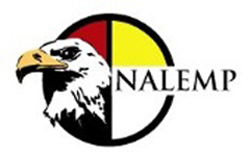
NALEMP is established under the National Defense Authorization Act. The purpose of the program is to address environmental impacts on Indian lands from former DoD activities with maximum tribal participation, through government-to-government consultation. Impacts that NALEMP helps address include:
- Hazardous Materials
- Munitions Debris
- Unsafe Buildings or Structures
- Lead-based Paint or Asbestos
- Abandoned Equipment
How To Report an Impact
- Posting a comment or report on the Native American Management System for Environmental Impacts (NAMSEI) system at www.namsei.com
- Contacting the DoD Senior Advisor and Liaison for Native American Affairs
- Contacting an applicable local or regional U.S. Army Corps of Engineers (USACE) District Office
Native American Management System for Environmental Impacts (NAMSEI) is an online system that allows tribal leaders and the public to access, report, and share information on DoD-related issues of concern. It also tracks and maintains information on over 1,100 potential impacts to tribal lands and resources resulting from past DoD activities. NAMSEI provides a historical record of site assessment results, presents a forum to report new suspected impacts, and receives online comments about assessments and project updates.
For more information or assistance, visit www.namsei.com or call 1-888-623-8748 (Toll Free)
Program Overview
Past DoD operational and training activities may have had adverse effects on tribal environmental health and safety, economic, social, and cultural welfare. In recognition of the need to address tribal concerns in DoD environmental programs, Congress has, since 1993, provided funds annually to mitigate environmental impacts to Indian lands and Alaska Native Claims Settlement Act (ANCSA)-conveyed properties.
NALEMP is the DoD environmental program that uses site evaluation and assessment processes, consistent with national environmental regulatory requirements, while also considering other potential effects on tribal communities’ way of life.
NALEMP-eligible sites are screened to determine priority for cleanup action based on health, safety, and environmental criteria. NALEMP reviews life-ways issues, or impacts to traditional ways of life, including the ability of tribes to conduct subsistence activities or access sites for cultural or religious purposes. In addition, the Program considers economic issues such as whether access to natural resources for commercial use and/or land for development is affected. NALEMP also reviews impacts to tribal programs and opportunities to leverage other federal or state agency support for cleanup action.
Most impacts from past DoD activities are addressed through the Formerly Used Defense Sites Program (FUDS), administered by the U.S. Army Corps of Engineers. Many Indian land sites are in the FUDS inventory of projects, but are not scheduled to be addressed for an extended period of time. Because of this situation, Congress has expressed concern and has directed special funding to address impacts of significance to tribes.
Program Eligibility
A potential mitigation project is eligible for NALEMP funding when all of the following criteria apply:
- Impact affects a federally recognized tribe;
- Impact is on eligible lands;
- Impact is attributable to past DoD activities;
- Impact will not be funded for mitigation by other government programs within the next three years.
Eligible lands include:
- Any land or title held in trust by the United States for the benefit of any Indian tribe or individual;
- Any land or title held by any Indian tribe or individual subject to restrictions by the United States against alienation;
- Any restricted Townsite deeds held by Alaska Natives pursuant to the Native Townsite Act, 44 Stat., 629, 25 May 1926 (repealed 1976), which are still held in trust;
- ANCSA-conveyed lands owned by ANCSA regional or village corporations.
Exemptions:
- Impacts already addressed under another DoD environmental program;
- Impacts on active installations or closing bases;
- Civil Works projects;
- Lands conveyed under ANCSA and reconveyed to a non-native entity or enterprise;
- Lands acquired by an Alaska Native Corporation outside of ANCSA.
Selection Process
DoD researches historic records, documents, and literature, and conducts interviews to evaluate all information about the reported impact. An onsite investigation occurs if additional information is needed. The reports are reviewed by all parties for accuracy and are entered into the NAMSEI system. NAMSEI helps track mitigation efforts and the exchange of information between the DoD and tribes.
All eligible sites are screened annually for available funding. When congressional funding becomes available, DoD uses information in NAMSEI to decide which sites to prioritize for funding. DoD considers factors other than risk to human health and the environment for cleanup of sites on Indian lands, including impacts to traditional practices, subsistence lifestyles, and economic viability.
DoD works with tribes with selected projects on a government-to-government basis to determine how best to mitigate the environmental impact(s). Under NALEMP, DoD enters into Cooperative Agreements with tribal governments to address problems attributable to past DoD activities. These agreements incorporate “traditional ecological knowledge” into the design for cleanup, involve the tribe in project decision making, and develop tribal capacity regarding environmental services and technical remediation skills. DoD has executed over 350 Cooperative Agreements with more than 60 tribal nations at a total funding level of over $160 million.
If the site is ineligible for NALEMP funding, DoD assists the tribe to identify other appropriate resources to help address the reported impact(s). Other potential funding sources may include other DoD, federal agency, or state environmental programs.
Program Success
- Assessed more than 90% of over 1,300 impacts reported to DoD
- Mitigated impacts at more than 100 sites
- Completed cleanup at nearly 100 sites (see partnership profiles below)
- Trained more than 3,700 DoD personnel in the skills to initiate effective consultation with tribal governments
Profiles of Successful DoD-Tribal Partnerships

